Bonsai trees come in a variety of unique shapes, each telling a story just as complex as the tree itself. Ever heard of Chokkan? It stands tall, symbolizing strength and stability. Then there’s the graceful Moyogi, with its S-shaped curves that dance like nature in motion. And let’s not forget about the rebellious Shakan, tilting boldly against the odds! Isn’t it fascinating how each form reflects resilience and beauty? Stick around, and I’ll share more bonsai secrets!
Quick Takeaways
- Bonsai trees exhibit various unique shapes, each representing distinct philosophies and aesthetics in nature.
- The Formal Upright style (Chokkan) symbolizes strength and stability through its balanced trunk form.
- The Informal Upright style (Moyogi) showcases graceful S-shaped curves, reflecting nature’s dance and spiritual growth.
- The Slanting style (Shakan) tilts dramatically, symbolizing resilience and capturing the essence of endurance.
- The Cascade styles (both Semi-Cascade and Cascade) emulate trees clinging to steep terrains, representing nature’s enduring beauty and adaptability.
Symbolism of the Formal Upright Bonsai Style
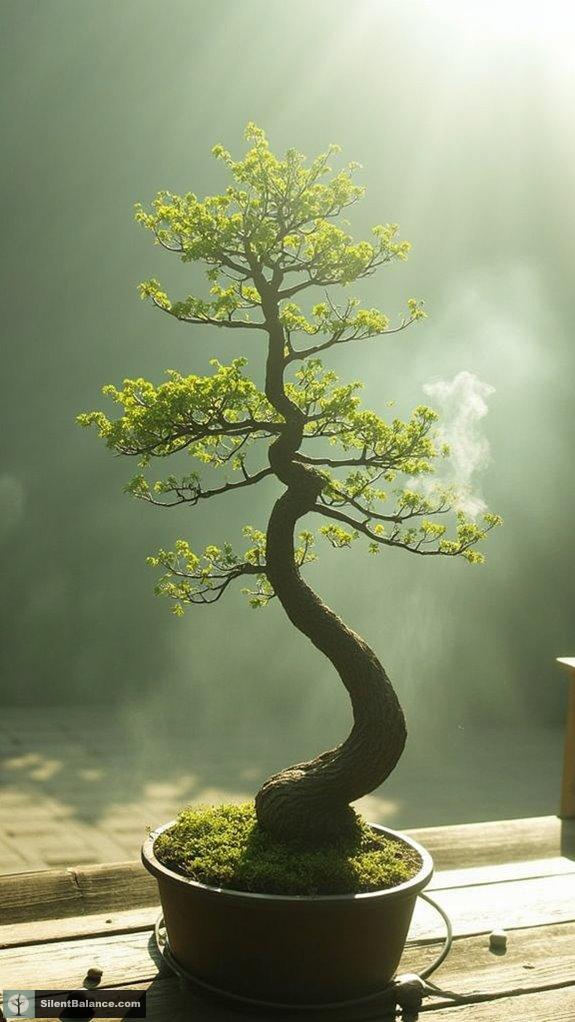
When you step into the world of bonsai, you quickly realize each style tells its own story, and the Formal Upright bonsai, or Chokkan, definitely stands tall in the narrative of nature.
I can’t help but admire how its straight trunk symbolizes strength and stability, like a resolute friend you can always count on. With its balanced form echoing calmness, it whispers the virtues of reliability and endurance.
Isn’t it intriguing how Chokkan mirrors life’s delicate dance between chaos and control? Pruning this beauty requires discipline, but the reward? A living proof of harmony. This meticulous shaping reflects the beauty and harmony of nature, showcasing the artistry that is essential in bonsai cultivation. Moreover, its design exemplifies the zen principles that encourage tranquility and mindfulness in everyday life.
Plus, it’s known to symbolize longevity—a perfect gift for milestones.
Its very presence invites mindfulness, reminding us to breathe deeply and embrace the now, even amidst life’s little tempests.
Embracing Nature With Informal Upright Bonsai
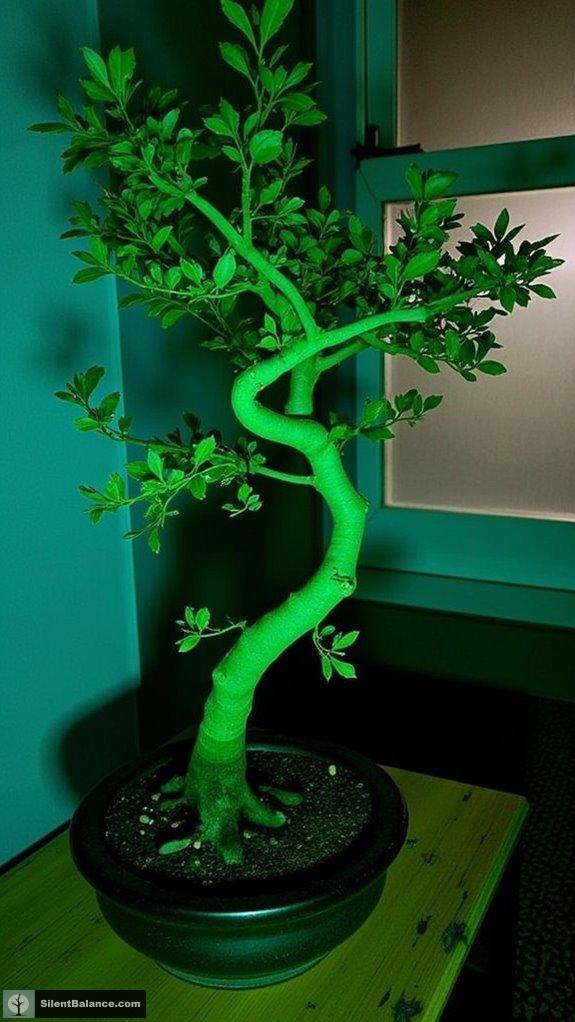
The world of bonsai goes beyond just beauty; it’s about embracing the essence of nature, and that’s where the Informal Upright style, or Moyogi, truly shines.
With graceful S-shaped curves, this bonsai feels alive, reflecting the gentle dance of nature. Have you ever seen how branches alternate along the trunk, each adding to its three-dimensional charm? It’s a symphony of balance and asymmetry. This style reminds us of the spiritual growth that can be inspired by nature’s resilience.
| Characteristic | Feature |
|---|---|
| Trunk Curvature | Gentle, natural bends |
| Apex Alignment | Directly above the base |
| Branch Placement | Alternating, outward sides |
It’s like nature’s art, beckoning you to explore its story of resilience and beauty. In choosing a tree species for your Moyogi, local climate compatibility ensures that your bonsai thrives beautifully. So, why not consider adding a Moyogi to your collection, and immerse yourself in this enchanting world?
The Tale of Resilience in Slanting Bonsai
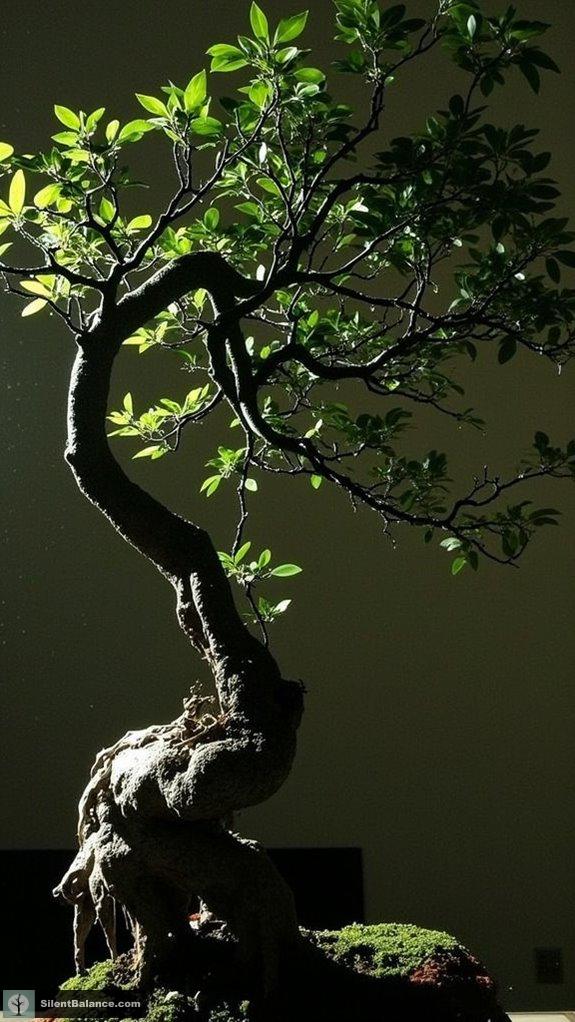
Though you’d think a tree’s strength lies in standing tall, the beauty of Slanting Bonsai, or Shakan, reveals otherwise.
After all, have you ever noticed the graceful way these trees tilt, as if whispering tales of resilience? Leaning at a bold 60 to 80 degrees, they mimic nature’s struggles against relentless winds and harsh conditions.
With roots robustly anchoring the lean side, they teach us that stability thrives even in imbalance.
And let’s not forget the branches! Growing opposite the slant, they create that delicious visual tension we bonsai lovers can’t resist.
It’s more than just artistry; it’s a philosophical statement about endurance.
Doesn’t that just spark a little joy? You can almost sense their triumph over adversity.
The Story Behind Semi-Cascade Bonsai
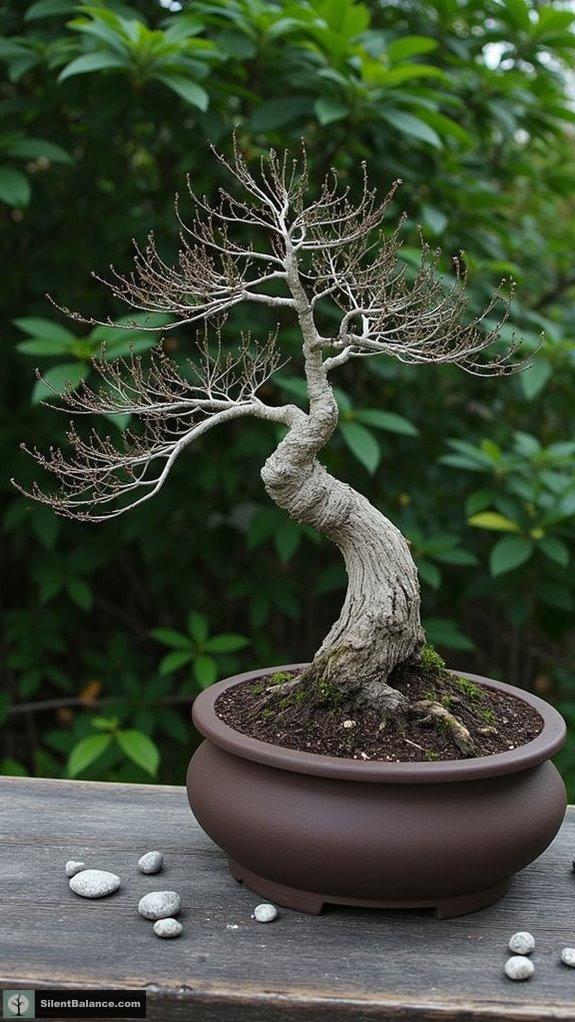
Shifting gears from the slanting elegance of the Shakan, let’s chat about the gem that’s Semi-Cascade Bonsai, or Han-Kengai.
Now, envision this: a trunk that elegantly bends downwards, but graciously stays above the pot’s edge—how delightful!
Unlike its wild cousin, the full cascade, the semi-cascade offers a softer, more subtle dance of branches, creating that laid-back vibe.
It’s like these trees are casually enduring the whims of wind and gravity, thriving on steep banks without going overboard.
And let’s not forget the pot—deeper than wide, a cozy home for those roots!
Isn’t it fascinating how this style wraps nature’s resilience in a frame?
Who wouldn’t want a piece of that balance and elegance in their home?
Evoking Dramatic Landscapes With Cascade Bonsai
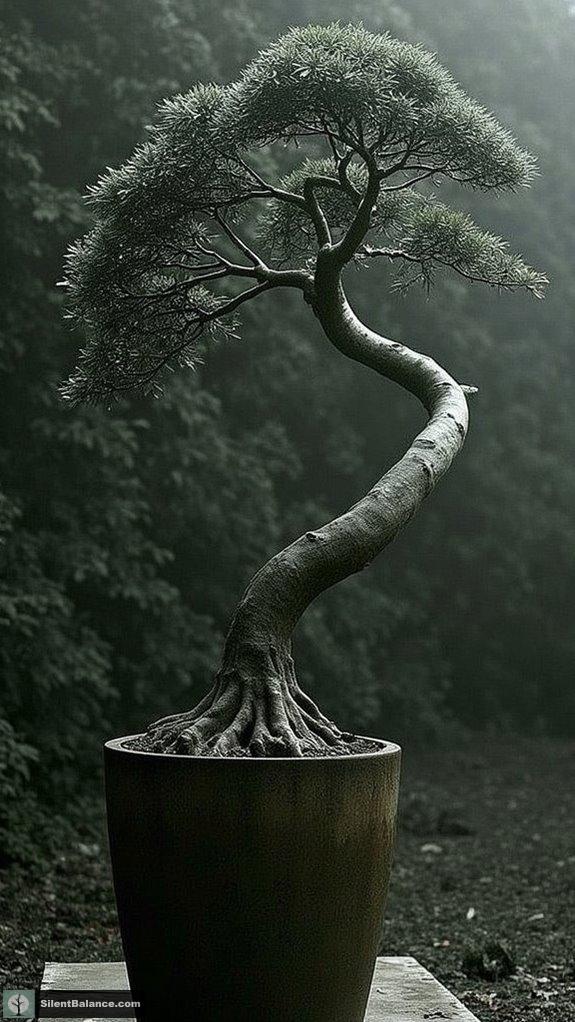
While we might marvel at majestic mountains from afar, envision capturing that awe in a tiny tree!
Cascade bonsai evoke those dramatic cliffs, with trunks bending down like they’re defying gravity. Isn’t it incredible how these little wonders mimic the resilience of trees clinging to steep terrains?
Their S-shaped trunks and balanced branches create a breathtaking silhouette, almost like a dancer in motion.
Imagine how these trees capture the relentless forces of nature, bending yet enduring.
I love displaying them in tall pots, showcasing that striking downward flow without touching the surface.
Exploring the Spiritual Meaning of Literati Bonsai

Diving into the spiritual essence of literati bonsai feels like wandering through an art gallery filled with whispers of wisdom and storytelling.
These miniature trees embody so much, inviting us to reflect on:
- Simplicity: The minimalist aesthetics mirror the elegance of a life well-lived.
- Resilience: They remind me that even in hardship—like trees struggling in dense forests—there’s beauty in survival.
- Contemplation: With their sparse foliage and flowing curves, they encourage us to ponder the impermanence of life.
Each literati bonsai seems to speak to a deeper connection between creator, creation, and viewer.
Doesn’t it feel invigorating to find such profound meaning in something so small?
Embrace the journey and let their stories inspire your spirit!
Bonsai Tree Symbolism
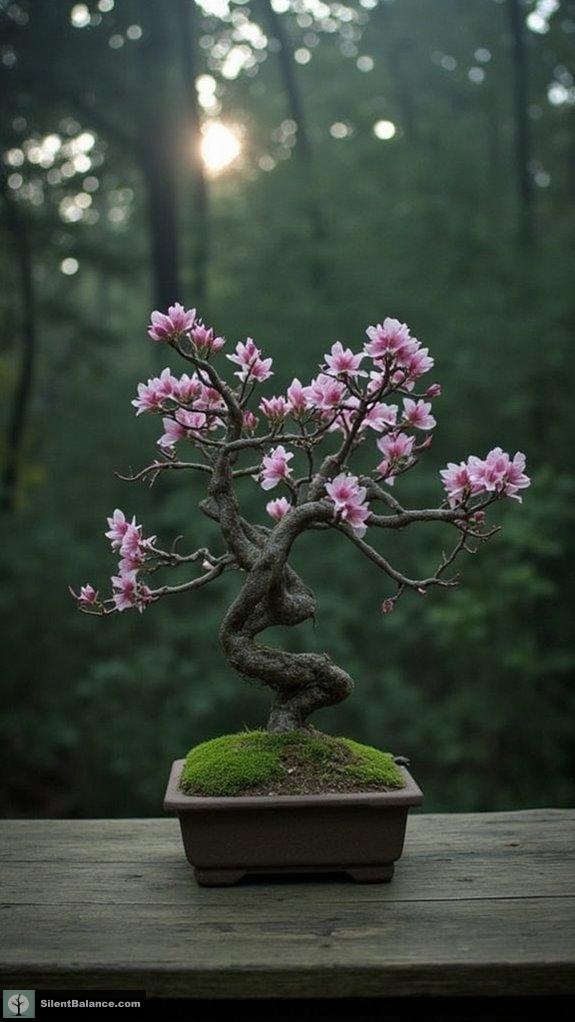
Every bonsai tells a story, and the significance behind these miniature masterpieces can be as complex as their twisted branches. Each bonsai serves as a canvas for life’s various lessons, embodying harmony, resilience, and beauty.
Here’s a snapshot of their symbolic meanings:
| Bonsai Type | Symbolism | Understanding |
|---|---|---|
| Azalea Bonsai | Feminine beauty and love | Perfect for nurturing relationships |
| Twisted Branches | Strength through adversity | Life shapes us, doesn’t it? |
| Flowering Bonsai | Cycles of renewal | Embracing change is essential |
| Fruit-Bearing | Prosperity and fruition | Good vibes for hard work! |
These tiny wonders invite us to embrace mindfulness and reflect on life’s beautiful chaos. Can you see how they resonate with you?
Tree Symbolism
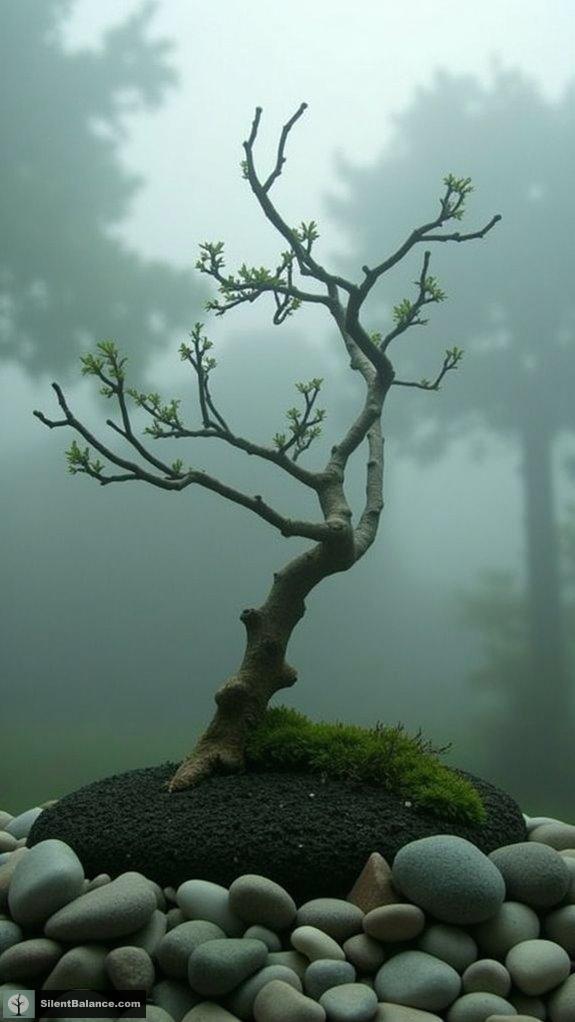
Trees are more than just the towering giants of nature; they’re the storytellers of life itself. Isn’t it fascinating how different cultures weave their own tales around these magnificent beings?
Consider this:
- In Asian traditions, the cherry blossom embodies beauty and impermanence.
- African cultures treasure the baobab, symbolizing strength and community.
- European lore highlights the oak, representing durability and longevity.
Each tree tells a story, connecting us deeply to our roots—both literally and figuratively!
The bonsai, resembling a miniature forest, carries these meanings too, inviting us to reflect on growth, resilience, and balance in our own lives.
Questions and Answers
How Do I Choose the Right Species for My Bonsai Style?
When choosing the right species for my bonsai, I picture a dance between nature and my hands. I weigh growth patterns, pruning skills, and climate needs, ensuring our journey brings harmony and beauty. It’s deeply rewarding.
What Is the Best Soil for Growing Unique Bonsai Shapes?
When I choose soil for my bonsai, I focus on a mix maintaining moisture yet draining well. I often use akadama, pumice, and lava rock; this balance really helps me grow resilient and unique trees.
How Often Should I Water My Bonsai Tree?
I know it feels intimidating to figure out bonsai watering. Trust me, I only water mine when the soil’s dry. I check often, adapting to weather and seasons keeps my bonsai thriving and happy.
What Tools Are Essential for Bonsai Shaping and Maintenance?
When shaping and maintaining my bonsai, I rely on essential tools like shears, concave cutters, wire pliers, and root rakes. Each tool plays a critical part in nurturing my beloved trees and enhancing their beauty.
Can Bonsai Trees Survive Indoors Year-Round?
Envision a tiny forest thriving on your windowsill. Yes, bonsai can thrive indoors year-round, especially tropical types like Ficus. Just guarantee they get the right light, warmth, and humidity, and they’ll flourish beautifully.
References
- https://www.bonsaiempire.com/origin/bonsai-styles
- https://www.gardeningknowhow.com/ornamental/trees/unique-bonsai-trees
- https://www.bbg.org/article/bonsai_styles
- https://easternleaf.com/bonsai-trees/bonsai-by-classification/
- https://bodiscience.com/Trees-by-Style-And-Shape-Plus-Pictures-389351
- https://indoor-bonsai-care.muragon.com/entry/454.html
- https://a-z-animals.com/blog/bonsai-tree-meaning-symbolism-and-significance/
- https://hookedonbonsai.com/bonsai-trees-in-literature-symbolism-and-significance/
- https://www.youtube.com/watch?v=lRvyfOMSiYc
- https://www.bonsaiable.com/blog/informal-upright-bonsai
- https://brusselsbonsai.com/styles-of-bonsai/
- https://longwoodgardens.org/blog/2023-05-17/beauty-bonsai-styles
- https://cincinnatibonsai.org/bonsai-tree-style-guide
- https://hookedonbonsai.com/bonsai-styles-and-soil-preferences-from-cascading-to-formal-upright/
- https://bonsai-arbor.com/exploring-shakan-style-discover-the-elegant-slanting-bonsai-trees/
- https://www.youtube.com/watch?v=DXNbxbnsbLQ
- https://wazakurajapan.com/blogs/news/learn-about-cascade-and-semi-cascade-bonsai-styles
- https://www.bonsaiable.com/blog/juniper-bonsai-styles
- https://orchidrepublic.com/blogs/news/discovering-different-bonsai-styles
- https://www.scribd.com/document/132534944/Cascade-Style-Bonsai
- Top 10 Bonsai Tree Designs for Miniature Home Greenery - September 5, 2025
- What Are the Easiest Bonsai Tree Species for Minimal Care? - September 5, 2025
- Best Bonsai Tree Species for Outdoor Seasonal Climates - September 5, 2025

